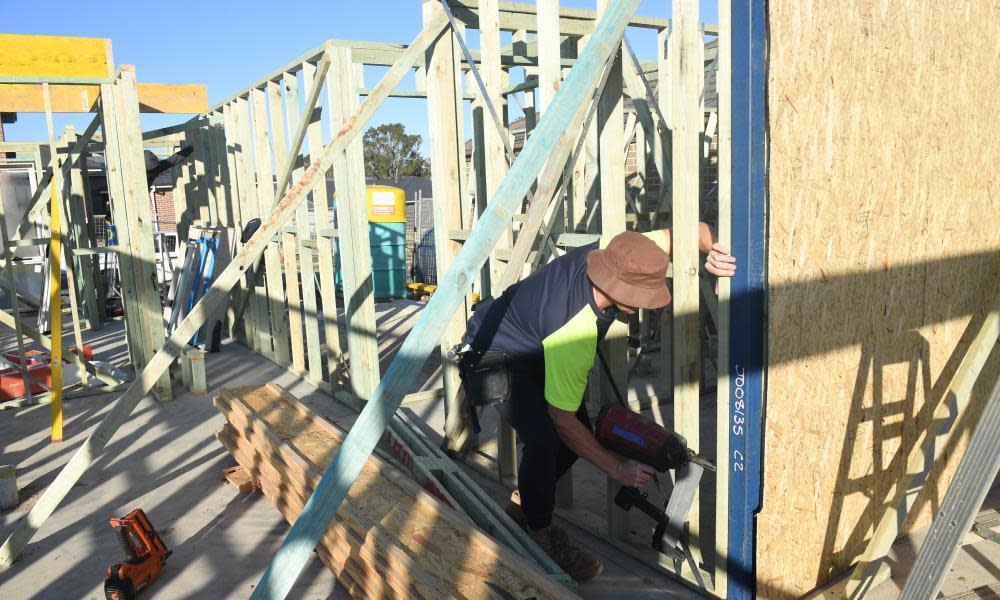The Coalition is relying on a struggling domestic economy to see us through an international crisis

As the impact of the coronavirus outbreak continues to wreak havoc on the world’s economy, the problem for Australia is that it has come at a time when our government has been more worried about the budget surplus than the actual economy. And now with the surplus almost certainly gone, the weak domestic economy is laid bare for all to see.
On Tuesday the prime minister, treasurer and health minister all fronted the media to deliver the bad news about the impact of Covid-19. For Josh Frydenberg and Scott Morrison the impact on the economy was just as important to highlight as that of the health concerns.
For a government that has placed so much store in achieving a budget surplus, the news was not good, but for the broader economy the news was worse.
Related: Morrison steps away from surplus pledge amid 'unknown global shock' of coronavirus
Morrison suggested “the Australian economy will depend a lot more on its domestic elements”. This is true because clearly the virus affects our exports, especially to China, but he also noted “business as usual can be maintained here in Australia within our domestic economy”.
That is a problem because the current business as usual in our domestic economy is pretty dire.
On Wednesday the bureau of statistics released the latest construction figures. These reflect the level of investment in the economy and are also important because the construction sector is one of our largest employers. Nine per cent of all employees work in construction, as does 17% of all men working full-time.
So when construction work falls, the economy generally struggles. And it has been struggling for a long time – and importantly was doing so before the impact of the bushfires and the coronavirus occurred.
In the December quarter of last year, the volume of construction work fell 1.4% in trend terms –the sixth consecutive quarter of falling work:
In the recent past the reason for the overall fall has been the end of the mining boom and the huge engineering construction done to build mines. But now the fall is as much about a decline in buildings being constructed:
In 2019 the volume of engineering construction fell 6.8%, but almost as large was the 6.5% fall in the construction of buildings.
Around 65% of buildings constructed in Australia are residential – either apartments and flats or houses. And the housing construction boom that began when the Reserve Bank cut rates at the end of 2011 is well and truly over.
Last year the volume of new residential construction fell in every state except for Tasmania, and even there the growth of 1% was well down on its recent peak of 40% growth in 2018:
The big concern is the decline in New South Wales. In 2019 new residential construction fell 23% – the biggest fall since 2001 when construction plummeted after people had rushed to build homes before the GST came into effect in 2000.
The decline of construction in NSW and Victoria highlights just how greatly those two states have been the centre of the boom.
At the start of 2010 the volume of new residential construction in those two states was roughly equal to that in the rest of the nation. By the middle of 2018 the amount of residential building in NSW and Victoria had doubled, while in the rest of the nations it had increased just 2%:
The mining construction and residential building booms are over. So what now?
Interest rate cuts started the last housing boom, but that was when the cash rate was 4.75% and the average discounted mortgage rate was 7.15%; now the cash rate is 0.75% and the discounted average mortgage rate is 4.15%.
Sure, there might be people waiting to build a home for when the Reserve Bank cuts rates one more time, but I suspect not a lot.
The market however still expects the RBA to cut the cash rate to 0.5% by July. Three months ago when the last construction figures came out, the market expected that would be as low as the cash rate would go. Now after the horror summer and Covid-19, the market believes there is a 50:50 chance that the RBA will do a further cut to 0.25%:
But even that suggests little real stimulus to come from the RBA.
And so we could look to the government.
It is clear that the public sector has not helped fill the gap left by the private sector. In the past year construction work done by the public sector has fallen. In effect it has accentuated the impact of the declining private sector at a time when it should be doing the opposite:
There has been a slight increase in public sector construction work in the past few months, but clearly not enough. Morrison suggested on Tuesday: “I can assure taxpayers ... we’re not a government that engages in extreme fiscal responses.”
Alas they appear not to be a government of any fiscal response. And what the latest construction figures make quite clear is that the domestic economy, which the government is relying on to see us through the international crisis, was already struggling well before things around the rest of the world turned ugly.
• Greg Jericho writes on economics for Guardian Australia


